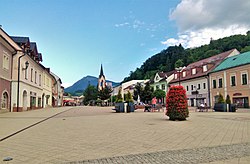Dolný Kubín
Dolný Kubín | ||
|---|---|---|
Town | ||
 Main square in the historical city centre | ||
|
Car plate DK | | |
| Website | www.dolnykubin.sk | |

Dolný Kubín (Slovak pronunciation: [ˈdɔlniː ˈkubiːn] ⓘ; also known by other names) is a town in northern Slovakia in the Žilina Region. It is the historical capital and the largest settlement of the Orava region.
Names
The name is derived from the archaic Slovak word klubin meaning a "glade covered by smoke after burnt roots".[4] Dolný Kubín means "Lower Kubín", in contrast with to Vyšný ("Upper") Kubín. The location and the settlement was known also as Kublen (1314), Clbin (1393), Culbyn (1408), Kubyn Nysny (1547), Dolny Kubin (1773). Other names in the past include German: Unterkubin, Hungarian: Alsókubin.
Geography
Dolný Kubín lies at an altitude of 468 metres (1,535 ft)
Climate
The
History

The first written reference of the location dates from 1314 and is about the land (not the settlement yet) Kubín. In 1325, the existence of "Superior Kolbyn" (Vyšný Kubín) was recorded what could indicate also the existence of Dolný Kubín, more detailed information about the settlement are from 1380s. The settlement belonged to the
After World War I, Dolný Kubín remained the seat of the Orava County until 1923, when Orava became a part of Váh County and it became the seat of its district. During World War II, the local garrison actively participated in preparation of Slovak National Uprising. Between December 1944 and January 1945, the town suffered from retaliatory actions and mass arrests. Red Army arrived to the town in the night from 4 to 5 April 1945, warmly welcomed by the local population.[8]
The town experienced major developments mainly after World War II, when electrical works as well as other enterprises were established.
Landmarks and culture
The
Demographics
According to the 2001
Twin towns — sister cities
Dolný Kubín is
 Braunau am Inn, Austria
Braunau am Inn, Austria Eger, Hungary
Eger, Hungary Kamianets-Podilskyi, Ukraine
Kamianets-Podilskyi, Ukraine Limanowa, Poland
Limanowa, Poland Pakrac, Croatia
Pakrac, Croatia Pelhřimov, Czech Republic
Pelhřimov, Czech Republic Svendborg, Denmark
Svendborg, Denmark Truskavets, Ukraine
Truskavets, Ukraine Zawiercie, Poland
Zawiercie, Poland
Personalities
- Pavol Országh Hviezdoslav (1849–1921), Slovak poet, born in nearby Vyšný Kubín, but lived and died in Dolný Kubín.
- Ladislav Nádaši-Jégé (1866–1940), Slovak author, born, lived and died in Dolný Kubín.
- Janko Matúška (1821–1877), author of Slovakia's national anthem, was born, became clerk of the district court, and died in Dolný Kubín.
- Juraj Laštík (b. 1987), Slovakian ski mountaineer
- Ján Johanides (1934–2008), Slovak writer
- Soňa Stanovská, slalom canoeist, born 27 February 2000 in Dolný Kubín.
See also

References
- ^ Statistical Office of the Slovak Republic (www.statistics.sk). "Hustota obyvateľstva - obce". www.statistics.sk. Retrieved 2024-02-08.
- ^ a b c d "Základná charakteristika". www.statistics.sk (in Slovak). Statistical Office of the Slovak Republic. 2015-04-17. Retrieved 2022-03-31.
- ^ Statistical Office of the Slovak Republic (www.statistics.sk). "Počet obyvateľov podľa pohlavia - obce (ročne)". www.statistics.sk. Retrieved 2024-02-08.
- ISSN 0023-5202..
- ^ a b c "Municipal Statistics". Statistical Office of the Slovak republic. Archived from the original on 2007-11-16. Retrieved 2007-12-12.
- ^ Climate Summary
- ^ Die Poststempel auf der Freimarken-Ausgabe 1867 von Österreich und Ungarn, Edwin Mueller, 1930, type G1.
- ^ a b Huba, Peter. "História mesta Dolný Kubín" (PDF) (in Slovak). Archived from the original (PDF) on 18 October 2016. Retrieved 15 October 2016.
- ^ http://www.dolnykubin.sk/sk/navstevnik/o_meste/historia_mesta/ Archived 2007-10-18 at the Wayback Machine (Slovak)
- ^ "Partnerské mestá" (in Slovak). Dolný Kubín. Retrieved 2019-09-03.
Genealogical resources
The records for genealogical research are available at the state archive "Statny Archiv in Bytca, Slovakia"
- Roman Catholic church records (births/marriages/deaths): 1672-1898 (parish A)
- Lutheran church records (births/marriages/deaths): 1787-1897 (parish A)
